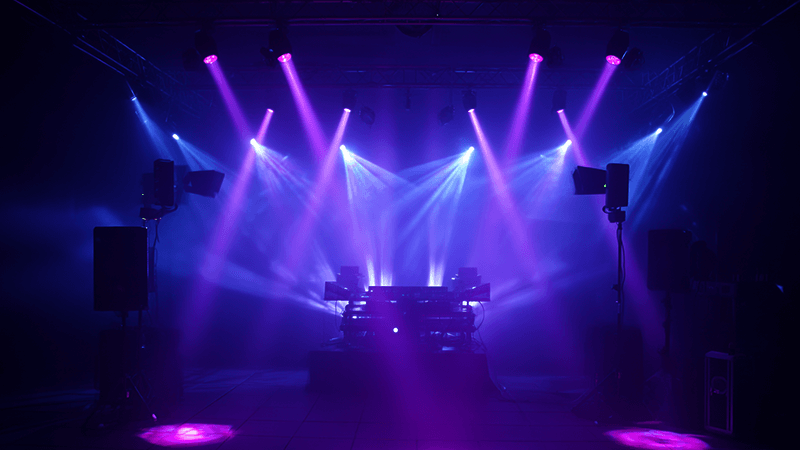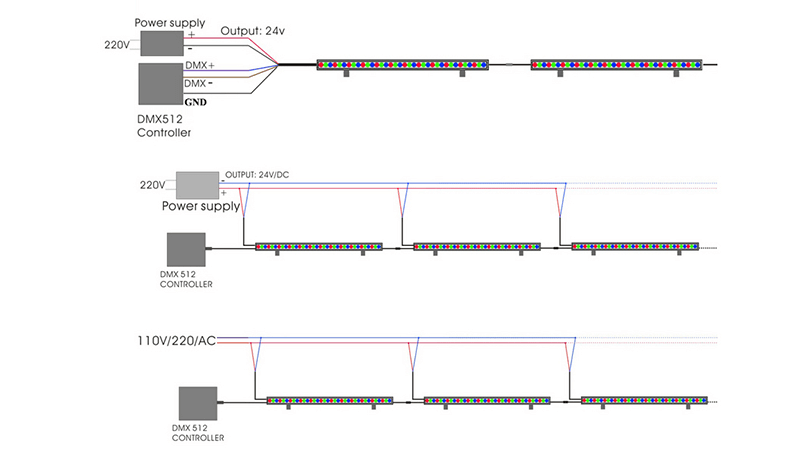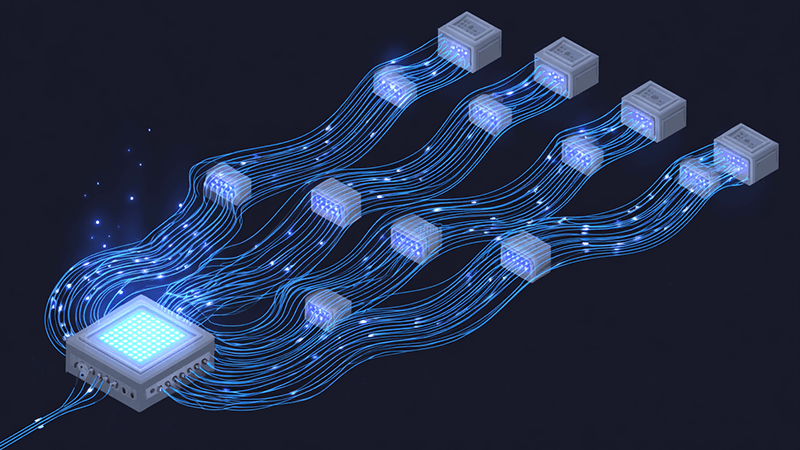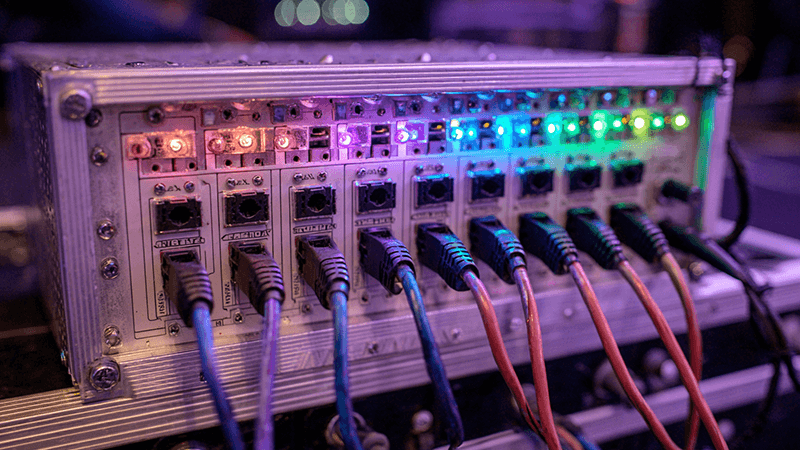Large projects with hundreds of RGBW floodlights often suffer from messy synchronization. This creates a chaotic look, ruining the entire lighting design and making your project appear unprofessional.
DMX512 synchronizes RGBW floodlights by sending digital commands from a central controller to each uniquely addressed light. This allows every fixture to interpret specific instructions for color and intensity, ensuring all lights change in perfect harmony across the entire project for a seamless visual effect.

As a manufacturer, I’ve seen countless large-scale projects. The ones that truly stand out are those with perfectly synchronized dynamic lighting. The magic behind this is almost always a well-implemented DMX512 control system. However, getting it right involves more than just plugging in some cables. I’ve been on job sites helping clients troubleshoot issues that could have been easily avoided. Let’s break down the common challenges and how you can overcome them to ensure your next large-scale project is a brilliant success.
How to connect multiple lights to a DMX controller?
Connecting hundreds of lights seems complex and overwhelming. A single wrong connection can disrupt the entire chain of lights, causing frustrating delays and headaches for your installation team on-site.
Connect multiple lights by ‘daisy-chaining‘ them. Run a DMX cable from the controller’s output to the first light’s input. Then, connect a cable from the first light’s output to the second light’s input, and continue this pattern. This creates a single, reliable line of communication.

The daisy-chain method is the foundation of any DMX layout. You create a single line of data flowing from the controller, through each light, one after the other. However, in large projects, this single line can become a point of failure. The DMX signal can only travel so far before it gets weak, a problem called signal attenuation. I remember a project in Dubai where the facade lights on a high-rise were flickering at the top floors. The DMX line was over 400 meters long without any support. The signal was simply too weak by the time it reached the last few lights.
To avoid this, you must follow two critical rules.
- Use a DMX Terminator. At the very last light in the chain, you must plug in a 120-ohm terminator. This small plug prevents the signal from reflecting back down the line, which can cause data errors and flickering lights. It’s a simple step that solves a major potential problem.
- Use a DMX Splitter/Booster. For long cable runs or when you have many lights, you can’t rely on a single daisy chain. A DMX splitter (also called an opto-splitter or booster) takes one DMX input and creates multiple, new, and amplified outputs. This not only boosts the signal but also isolates your lines. If one line of lights has an issue, it won’t affect the others.
| Connection Method |
Pros |
Cons |
Best For |
| Simple Daisy Chain |
Easy and cheap to set up. |
Signal weakens over distance (max ~300m). A single fault can affect the whole line. |
Small projects with few lights and short cable runs. |
| Using a DMX Splitter |
Boosts signal for longer runs. Isolates lines for reliability. Simplifies troubleshooting. |
Higher initial cost. Requires more planning and cables. |
Large projects, installations with long distances, and mission-critical applications. |
For any project involving more than 32 lights or cable runs over 100 meters, I always recommend using a DMX splitter. It’s an investment in reliability. Installing a splitter halfway up that Dubai high-rise instantly solved their flickering issue.
How to sync LED lights together?
You’ve connected all your lights, but now they won’t change colors in unison. This makes your lighting display look amateurish and unprofessional, undermining the quality of your fixtures and installation.
To sync lights, you assign them DMX addresses. Lights given the same address will act identically. For individual control, each light gets a unique starting address. You then program scenes on the DMX controller, which sends commands to these addresses, creating perfectly synchronized effects.

Synchronization all comes down to addressing. Think of the DMX address as the house number for each light. The controller is the mailman, sending out letters (commands) to specific addresses. If two lights have the same address, they get the same letter and do the same thing. If they have different addresses, they can be controlled independently. An RGBW floodlight typically needs four channels: one for Red, one for Green, one for Blue, and one for White. So, if your first light is addressed to ‘1’, it uses channels 1, 2, 3, and 4. The next light must be addressed to ‘5’ to avoid an overlap, and it will use channels 5, 6, 7, and 8.
On a large project with hundreds of fixtures, setting these addresses manually is a huge task. It’s slow, and mistakes are very easy to make. I’ve seen projects delayed by days because one light was misaddressed, causing a whole section to behave incorrectly. To prevent this, a strict "set-and-verify" process is essential, where one person sets the address and a second person confirms it against a detailed plan.
However, the ultimate solution is to use fixtures that support RDM (Remote Device Management). RDM is a protocol that allows two-way communication over the DMX line. It lets you use the DMX controller to remotely see, configure, and set the address of every single light in the system. On a large bridge project with over 600 floodlights, we insisted on RDM-enabled fixtures. From the control room, we addressed and tested every light without needing a single person on a ladder or lift. For a purchasing manager, specifying RDM-enabled fixtures is a game-changer for project efficiency and long-term maintenance.
How does DMX512 work?
The term "DMX512" sounds technical and intimidating. Not understanding the basics can lead to poor system design choices, making it difficult to troubleshoot problems when they inevitably come up on site.
DMX512 is a digital communication standard. A controller sends a "packet" of 512 channels of data, repeated about 44 times per second. Each channel has a value from 0 to 255. A light fixture listens to its assigned channels to control functions like color or intensity.

Let’s simplify it. Think of DMX512 as a language that lighting equipment uses to talk to each other.
- A "packet" is like a sentence containing 512 words. Your controller sends this sentence out over and over, very quickly.
- A "channel" is one of those 512 words. Each channel is a specific instruction.
- The "value" (0-255) is the content of that word. For a dimmer channel, 0 means ‘off’ and 255 means ‘full brightness’.
For a typical RGBW floodlight, it is listening for four specific channels. The value on the first channel tells it how much red to use, the second how much green, and so on. By mixing these four values, you can create millions of different colors.
| DMX Channel |
Assigned Function |
Value (0-255) |
Resulting Output |
| Address 1 |
Red Dimmer |
255 |
Full intensity red |
| Address 2 |
Green Dimmer |
0 |
No green |
| Address 3 |
Blue Dimmer |
0 |
No blue |
| Address 4 |
White Dimmer |
127 |
50% intensity white |
Because this is a digital signal sent over a cable, it can be corrupted by outside interference, known as Electromagnetic Interference (EMI). If your DMX cables are run next to high-voltage power lines, large motors, or radio antennas, the DMX cable can act like an antenna itself, picking up electrical noise. This noise scrambles the DMX "language," and your lights will start to flicker or change color randomly. The solution is to always use proper shielded twisted-pair DMX cable. The shield protects the signal from outside noise. You must also connect this shield to ground at only one end of the cable run (usually at the controller) to prevent other issues.
How many lights can a DMX controller handle?
You have a massive project and you’re worried if one controller is enough. Exceeding your controller’s limits can lead to system failure, unexpected behavior, and costly last-minute additions to your budget.
A single DMX line, or "universe," handles 512 channels. The number of lights this controls depends on how many channels each light uses. For example, you can control 128 four-channel RGBW lights per universe (512 / 4 = 128).

The term "DMX Universe" is key here. One universe is one set of 512 channels, sent down one DMX cable line. So, the question isn’t just about the number of lights, but the total number of channels you need. A simple white fixture might only use one channel, meaning you can have 512 of them on one universe. A complex moving light might use 20 channels, so you could only have 25 of them (512 / 20 = 25.6).
When your project’s total channel count exceeds 512, you simply need more universes. Most professional DMX controllers have multiple universe outputs. You might use Universe 1 for the ground floor of a building, Universe 2 for the middle floors, and Universe 3 for the top. Each universe gets its own DMX output from the controller and its own separate daisy chain of lights.
However, there’s another critical limit that often gets overlooked: power. Even if your controller can signal thousands of lights across many universes, you can’t power them all from the same place. I once consulted on a stadium project where lights on the far side would dim or shut down during big moments. The controller was fine; the problem was power. The electrical cables running to those lights were too thin for the distance, causing a huge voltage drop. The lights weren’t getting enough power to operate correctly. This was a costly mistake, requiring them to pull new, thicker power cables. That lesson taught me that the DMX control design and the electrical power design must be planned together, not separately. For any large outdoor project, it is also essential to install professional Surge Protective Devices (SPDs) on both the power lines for the lights and for the DMX control system to protect your expensive equipment from power surges and lightning.
Conclusion
DMX512 offers powerful, precise control for large lighting projects. Success relies on robust connections, smart addressing, clean signal paths, and a solid power design to achieve a flawless, synchronized display.